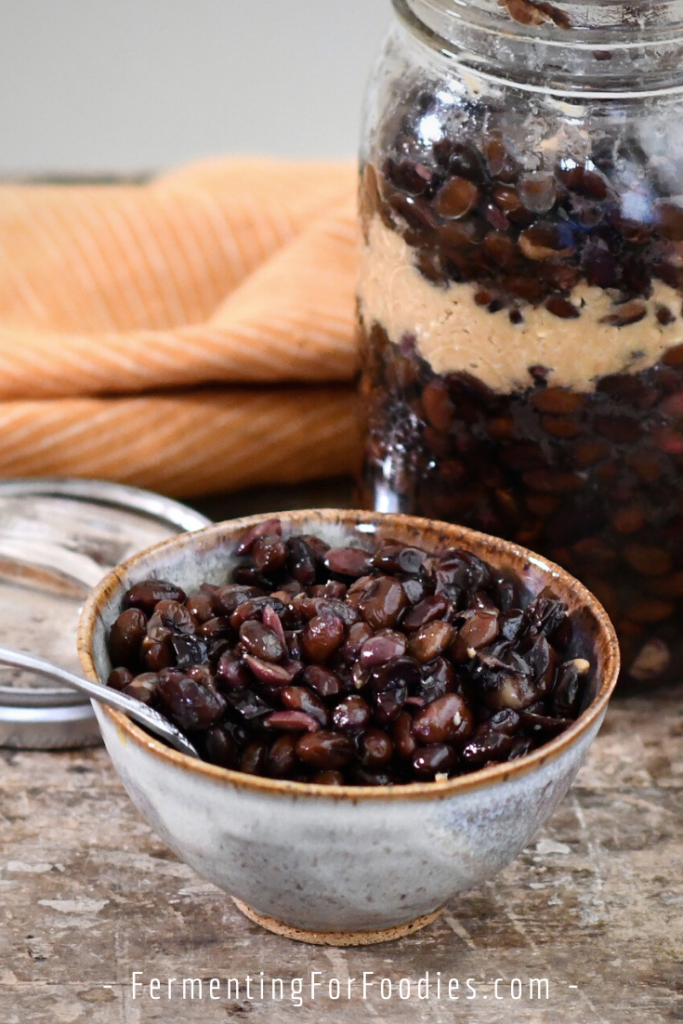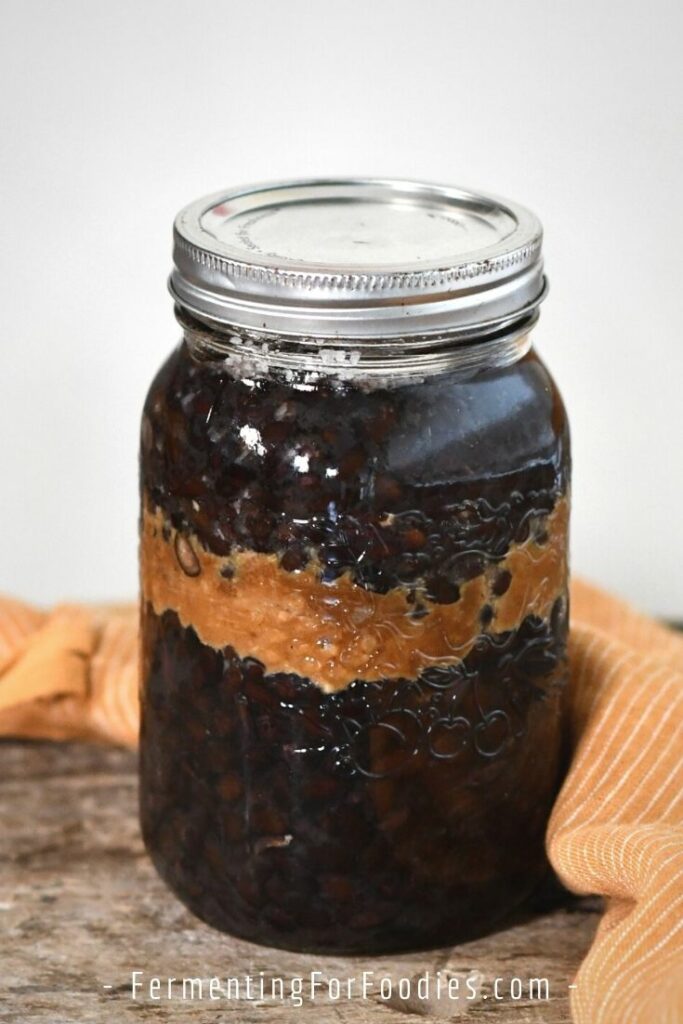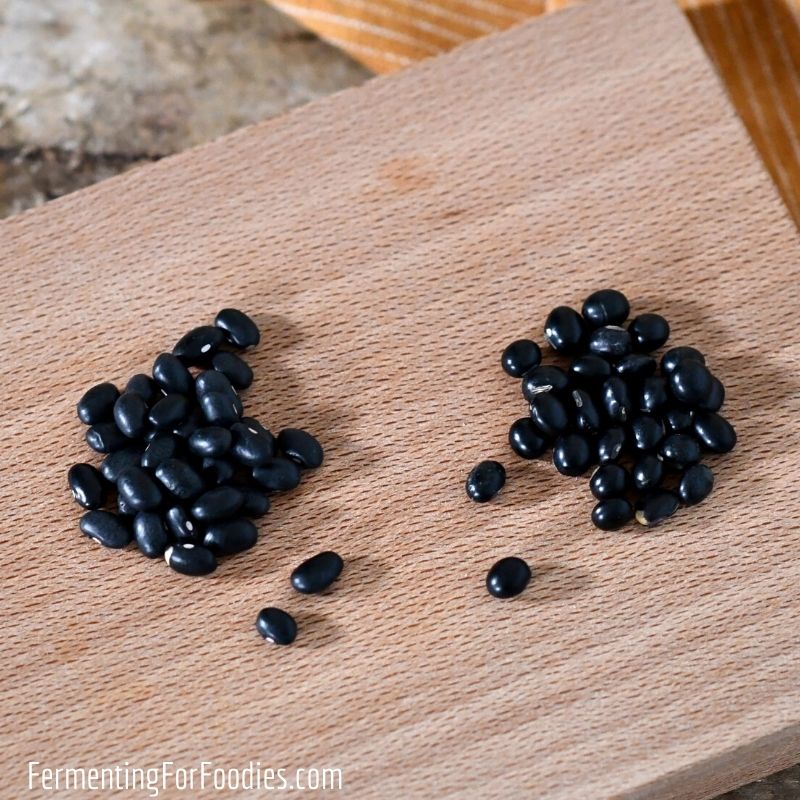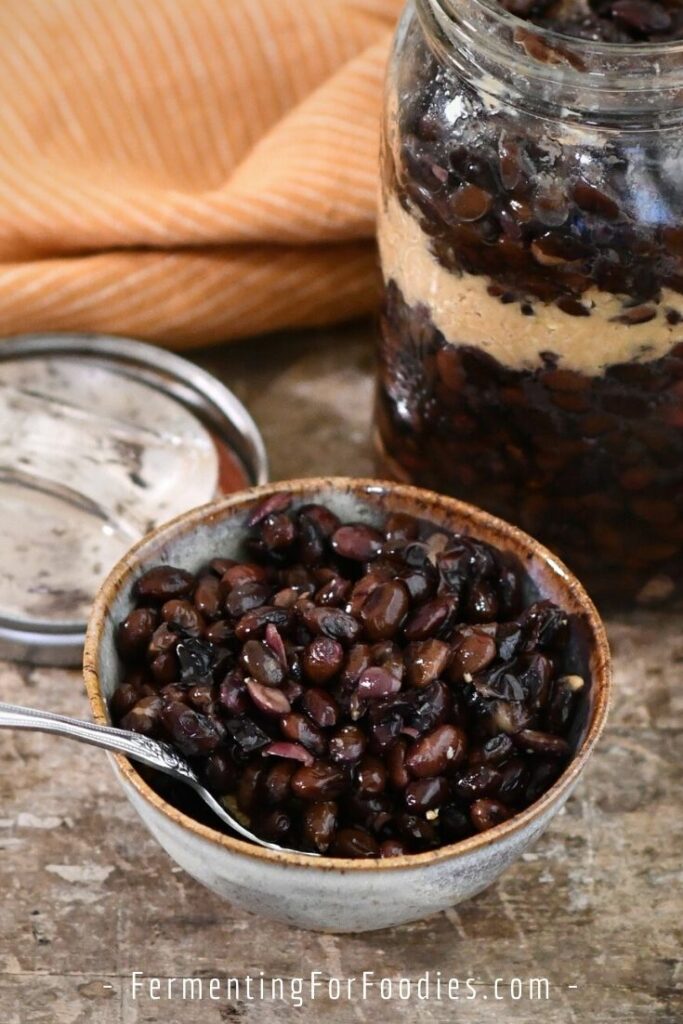This simplified fermented black beans (douchi) recipe uses miso or live fermented douchi as the culture. It’s an easy DIY option for this flavorful Asian ingredient.

Traditional Douchi (fermented black beans) involves a two-stage process.
- First, black soybeans are inoculated with mold in a process that is more similar to making tempeh than miso.
- After 24 hours, the mold will have started to spore. The spores are washed off the beans.
- Then the beans are packed into a brine to ferment for several months.
Most home cooks don’t have time for this sort of multi-process ferment. Here is a simpler method that results in a very similar flavor. It’s a perfectly good alternative for most Fermenting Foodies.
Douchi culture
The recipe below uses live, fermented black beans or miso as a culture. I set mine up as a continuous ferment. Once my jar of black beans is dwindling, I pack it with freshly prepared black soybeans for another round of fermentation.
Probably the hardest part of this recipe is finding the live fermented black beans. Here’s some advice:
- Do not use products with fermented black beans in them. No fermented black bean sauce or garlic sauce with black beans, etc..
- Dried fermented black beans may have live culture, but it won’t be very vigorous, so I don’t recommend it.
- I haven’t been able to find a good resource for live douchi online, so I can’t recommend that! (If you find one, please share in the comments!)
- Your best bet is to head to an Asian grocery store with a large amount of stock.
If you are unable to find live douchi for a culture, then use live miso instead. They start with the same mold culture (koji), so it’s the best available alternative.

Black beans versus black soybeans
Black soybeans are a bit harder to find. However, they’re quite different from regular black beans, so I recommend making the effort. If you can’t find them in your local Asian grocer or bulk food store, you can always order them online.
What are the differences?
- Soybeans are rounder, denser, and take longer to cook.
- They have a different flavor, aroma, and texture.
- However, the important thing is that black soybeans have way more protein, vitamins, and minerals and a lot less carbs.
- If you can’t find black soybeans, use regular soybeans instead.

What can you do with Fermented Black Beans?
Brad is SO into hot sauce, chili sauce, and stir-fries. We take turns cooking quick weeknight dinners… and he makes a stir fry every week. It’s so quick, simple, and perfect for whatever vegetables are in season. He uses douchi to add umami to our stir fries.
Here are a few ways to use your fermented black beans.
- Add them to a stir fry.
- Make black bean sauce for stir fries or as a condiment.
- Use them to add depth to homemade chili oil.
- They add salt and flavor to pretty much any dish, like these sautéed green beans!

Fermented Black Beans (Simplified Douchi)
This simplified fermented black beans (douchi) recipe uses miso as the culture. It’s an easy DIY option for this Asian ingredient.
- Prep Time: 15 minutes
- Cook Time: 1 1/2 hours
- Total Time: 0 hours
- Yield: 1 quart jar 1x
- Category: Condiment
- Method: Fermented
- Cuisine: Asian
- Diet: Vegan
Ingredients
- 1 3/4 cups dried black soybeans
- Water for soaking and cooking
- 6 Tbsp of salt, divided (non-iodized)
- 1/2 cup of live fermented black beans or miso
Instructions
-
- Soak the beans overnight. Use enough water to keep the beans covered even if they double in size.
- Drain the water, refill the pot with fresh water, and bring the beans to a boil. Reduce the heat and simmer until the beans are soft, about 1 1/2 hours.
- Drain the beans, reserving 1/2 cup of cooking water. Allow the beans to cool down to room temperature (about 1 to 2 hours).
- When the beans have cooled, sprinkle on 5 Tbsp of salt.
- Place 1/2 of the beans in a 1-quart glass jar. Add in 1/2 cup of fermented black beans (or miso), then top with the remaining freshly cooked soybeans. You may need to press the beans down to get them all in the jar.
- It’s fine that the culture isn’t fully mixed into the jar. Placing it in the center of the jar will ensure that the mold, yeast, and bacterial cultures will spread throughout the beans.
- Sprinkle 1 Tbsp of salt on the beans, then place a weight on top. Pour the reserved water overtop so the beans are completely submerged. Leave an inch of headroom at the top of the jar to prevent the liquid from bubbling over as it ferments.
- Cap with a lid that will allow CO2 to escape. I find that a loosely tightened jar lid works well.
- Leave the jar somewhere dark to ferment for at least 2 months (though waiting up to 6 months is ideal).
- Once you start to use the black beans, store the jar in the fridge. I recommend starting a second batch when you’ve used up roughly half the jar. That way your second batch will be ready by the time you are completely finished with the first batch.



I just made this and it looks just like yours. Confuses, though, since when I buy douchi it is dry beans. Do you dry the beans after the “underwater” fermentation process? Recipe doesn’t say. Thanks!
The beans are quite dry when you remove them from the brine. The salt actually draws the water out of them so they are quite like store-bought douchi. There’s no need to do additional drying. Thanks for trying the recipe! Let me know how it works out for you.
Thanks Emillie! So when the fermentation is done (2 to 6 months) you remove beans from the brine (do you rinse?) and allow them to air dry before storing them like (“dry”) fermented black beans from the store?
I recommend keeping them in the brine as it is the best way to preserve them. If you want them to be dry for your cooking, simply remove them from the brine and let them air dry for an hour. I think you’ll be surprised by how dry they’ll end up being! I know that store-bought fermented black beans often come in vacuum-sealed bags, but I suspect that’s for easy shipping more than anything. Cheers!